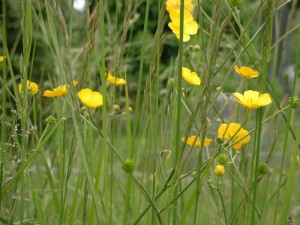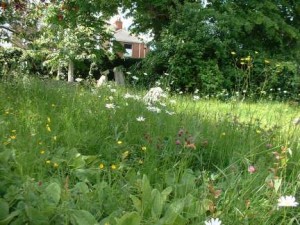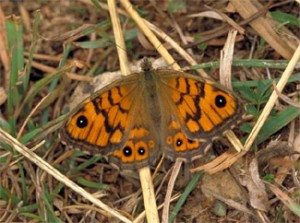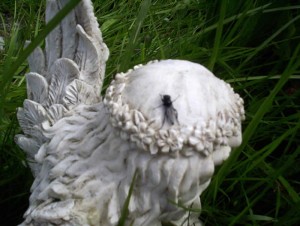Nature in Ryde Cemetery – May 2008
On Saturday 3 May Carol and I had our monthly Nature Walk at about noon and this time we were joined by Liz, Rachael, Kate and Cynthia and it was a sunny and pleasant day.
We found a spider’s nest (image) in a Flower vase on a grave and there were many baby spiderlings but they did not make any movement so we supposed they were not yet ready to hatch.

Spiderlings
The Primroses that have been in so much profusion for the last couple of months are now coming to the end of their season. Daisies, Buttercups (image) and Bluebells are now the most visible flowers on show.

Buttercups
We found quite a lot of wild meadow flowers in bloom: Ribwort Plantain, Dandelions, Bugle, Red Campion, Vetch both Tufted and Common, Red Clover, Common Groundsell, Goose grass, Black Medick, and Chick weed.

Meadow flowers
Germander Speedwell (image) is also to be found in several places all over the cemetery. Now they give large patches of bright blue, unmissable. In March when we started it was a thrill just to find one small flower now they are everywhere.

Germander Speedwell
Along many of the paths the daisies are like a carpet. There is an old country saying “Prove that summer is here, if you can stand on ten daisies with one foot” and by that measure we can say that summer is definitely here now.

Black Meddick is easily identifiable by its yellow pea flowers and clusters of tiny seed pods which become black as they ripen. The small yellow flowers are in a crowded cluster on a long stalk and the leaves are trifoliate and have a minute terminal leaf on each leaflet.
Sprawls over grassy places and wasteland.
Normally flowers May to August.
Ribwort Plantain
Plantago lanceolata (Plantaginaceae)

A common grassland weed, easily overlooked until its anthers are mature. The anthers are large and white and form a ring around the flower head. The brown sepals give it a rusty look. The leaves are long and narrow and are clustered around the base of the long flower stem which is tough and fibrous.
Forms extensive patches in meadows and pastures.
Normally flowers April to October.
The trees in the cemetery are now in full leaf, especially the Oak tree that is a picture covered with fresh pale green leaves. The Chestnut trees at the Pellhurst Road end of the cemetery are also in flower. The Horse Chestnut is covered with ‘candles’ of white flowers promising a good batch of ‘conkers’ later in the year. There is another chestnut tree with pink flowers and I think this a hybrid between the Horse Chestnut and the Red Buck-eye from North America. The Beech trees are in bud but not fully open yet.
There are three flowering cherry trees near the wall in West Street and they too have been a picture (see image) but now the wind and rain have blown away most of the petals.

Cherry trees by the Old Chapel
We did not see too many birds as lunchtime is perhaps not the best time for bird watching. We did see a couple of mating Blackbirds and they could be heard singing in the trees. We also saw a couple of starlings (see image), a rook, a few sparrows and of course the wood pigeons.

Starling
We also saw several small blue butterflies some pairing up, which I think are called Holly Blue’s, we also saw a small brown butterfly which I think was Wall Brown (see image) from: http://www.butterfly-guide.co.uk/species/satyrids/ukm11.htm

Wall Brown Butterfly
There were also a lot of flying insects; black flies with long dangly legs, these were difficult to photograph (see image) but we discovered they are called St Mark’s flies, because they usually appear every year around the April 25th, St Mark’s Day, and stay around for a couple of weeks. They are also known as Hawthorn flies.

St Mark’s Fly
Maisie Kitching (Text and painting of Starling)
6 May 2008
Photographs contributed by Janette Gregson (from Nature Gallery), Sally-Ann Garrett (from Nature Gallery), Rachael Mead (taken on the day) and Wall Brown Butterfly from the website: http://www.butterfly-guide.co.uk/species/satyrids/ukm11.htm

